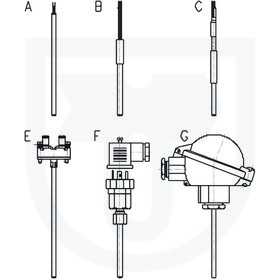212 Resistance temperature sensor without protective armature (jacketed)(Ex ia)
- For such temperature measurement, where the following is required
- Short time of temperature response (fast response of the sensor to a change of the measured temperature)
- Small dimensions and flexibility of the sensor (possibility of shaping the stem of the sensor)
- High mechanical resistance to shocks and vibrations
- Resistance to fast changes of temperature
- High insulation resistance at normal ambient temperature also in high temperatures
- Good general resistance to corrosion, resistance to corrosion under voltage
- High accuracy of measurement
- Good resistance to inter-crystalline corrosion also after welding, good resistance to heavy oil products, steam and exhaust gases, good resistance to oxidation
- Maximum temperature of application up to 600°C - for potentially explosive atmosphere in the areas of Zone 2, Zone 1 and Zone 0 pursuant to EN 60079-10 1 during the application of the converter Ex ia or in connection to the Ex ia circuit
- In design with converter for the transfer of the signal of the resistance sensor to a unified output signal 4 to 20 mA or signal digital (converter with HART protocol)
- For the environment, where mechanical resistance is required pursuant to EN 60068-2-6 (class AH2) and seismic capability of the electrical equipment of the safety system of the nuclear power stations pursuant to IEC 980 (MVZ level SL-2)
- special design for cryogenic environment with medium temperature up to -196 °C
- The areas of application can be e.g. nuclear energy, steam boilers, pressurized water reactors, aircraft engines, processing plastic materials, paper industry and food industry.
- The sensors with converter or Ex ia design are rated products pursuant to the Directive 2014/30/EU of the European Parliament and the Council and EU Declaration of Conformity EU - 212000 is issued for them.
Appendices to download
Click on the title of an appendix to download it
- 1) Product manual 212 (PDF 0.4 MB)
- 2) EU declaration of conformity 212 (PDF 0.5 MB)
